Electric vehicles may be getting most of the attention these days, but when it comes to financial sense and long-term depreciation, hybrids are emerging as the wiser investment.
A recent report from car search website examined more than 800,000 used cars to identify which models retain the most value after five years. The findings are striking: hybrids, particularly those made by Toyota and Honda, are holding their value significantly better than fully electric vehicles.
On average, hybrid cars depreciate by only 40.7% after five years, while electric vehicles lose an eye-watering 58.8% of their original value over the same period.
In comparison, the industry-wide average depreciation across all vehicle types is 45.6%. Below are the top ten hybrid models that maintain their value the best over time.
Toyota RAV4 Hybrid — 31.2% depreciation
The Toyota RAV4 Hybrid ranks first, with the lowest five-year depreciation rate of any hybrid currently available. It loses just 31.2% of its original value, meaning owners can retain close to 70% of their initial investment. In dollar terms, that translates to an average loss of only $10,062 — impressively low for a compact SUV.
The reasons behind its strong value retention are clear: the RAV4 Hybrid combines Toyota’s well-known reliability with excellent fuel efficiency and the practical appeal of an SUV. As more drivers search for efficient vehicles capable of handling diverse weather conditions, the RAV4 Hybrid has found a highly desirable niche.
The sixth generation of Toyota’s best-selling model, the RAV4 compact SUV, is set to debut with a more modern design, updated technology, and revised mechanicals, all aimed at keeping this top-selling crossover competitive in an increasingly crowded segment.
With hybrid variants already accounting for a significant portion of RAV4 sales, Toyota is expected to place even greater emphasis on electrified powertrains.
Additionally, the company may highlight its off-road roots by introducing more rugged trims, possibly including a TRD Pro version similar to what is offered on the larger 4Runner and Tacoma models.
This update is especially important because the RAV4 isn’t just Toyota’s top seller—it’s also the best-selling non-pickup vehicle in the United States.
Toyota sold nearly half a million RAV4s in 2024 alone, making it critical that the new model continues to resonate with consumers. The current generation has started to show its age, particularly in areas such as design, refinement, and performance.
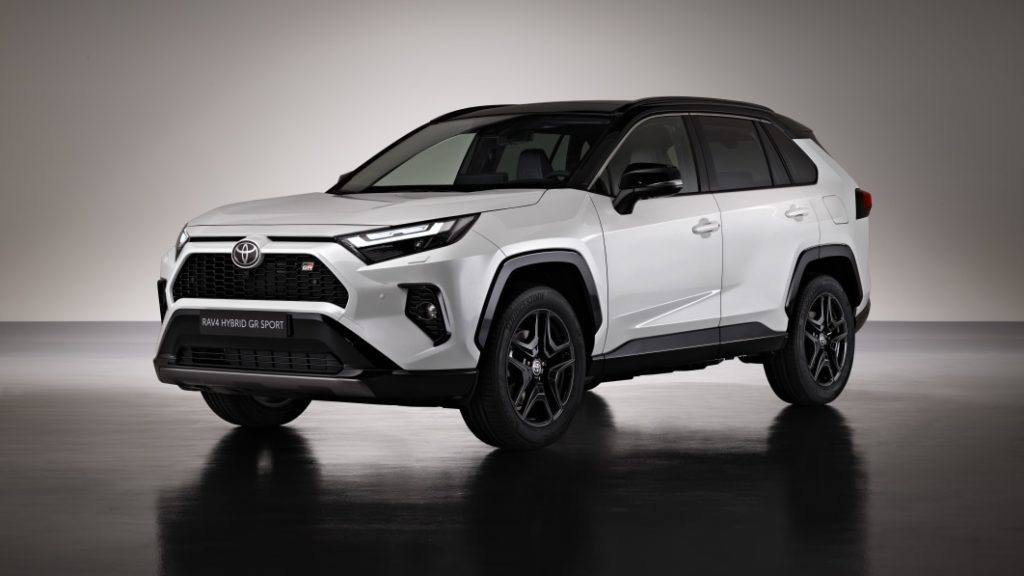
It recently placed sixth out of eight in a comparison test of compact SUVs, signaling the need for significant improvements to remain competitive with class leaders while maintaining its solid reputation for reliability and practicality.
The 2026 RAV4 will be built on Toyota’s TNGA architecture, specifically the TNGA-K platform, which also underpins many other vehicles in the automaker’s lineup. This platform provides a solid foundation for enhancing the RAV4’s driving dynamics and overall refinement.
There is a strong likelihood that Toyota will move to an all-hybrid lineup for the RAV4, just as it has done with the newest Camry.
The expected powertrain will likely mirror that of the Camry’s hybrid system, which combines a 2.5-liter inline-four engine with electric motors to deliver a total output of 225 horsepower with front-wheel drive and 232 horsepower with an all-wheel-drive setup that includes an electric motor for the rear wheels.
The plug-in hybrid version, formerly known as the RAV4 Prime, is also expected to return. Fans will hope it maintains the impressive 302-horsepower output and the quick acceleration that made the current model a standout.
The new RAV4 will continue to face stiff competition from popular compact SUVs such as the Chevrolet Equinox, Ford Escape, Honda CR-V, Hyundai Tucson, and Nissan Rogue. Each of these models brings its own strengths to the table, making the segment highly competitive and forcing Toyota to innovate to stay ahead.
However, Toyota runs the risk of playing it too safe with this redesign. If the new RAV4 lacks distinctive styling or fails to deliver meaningful improvements in driving refinement—especially in the areas of powertrain noise, vibration, and harshness (NVH), which have been weak points for the current model—it could lose ground to more ambitious rivals.
In a crowded field of strong contenders, failing to deliver a noticeable step forward could make it difficult for the RAV4 to maintain its dominant position.
Toyota Prius — 34.9% depreciation
The Prius may not boast eye-catching styling or cutting-edge flair, but its resale value is among the best in its class.
Depreciating just 34.9% after five years, it easily outperforms many gasoline sedans and electric vehicles in terms of value retention. Known for its exceptional reliability and ultra-low fuel costs, the Prius is a smart long-term choice.
The data makes that point crystal clear: owners see an average loss of just $9,908 over five years, underscoring the Prius’s appeal to budget-conscious buyers who prioritize savings over time.
The Toyota Prius is a groundbreaking hybrid vehicle that revolutionized the automotive industry by making hybrid technology mainstream. First introduced in Japan in 1997 and launched globally in 2000, the Prius became the world’s first mass-produced hybrid car and is widely recognized for its exceptional fuel efficiency and eco-friendly design.
It uses Toyota’s Hybrid Synergy Drive system, which combines a gasoline engine with one or more electric motors to maximize fuel economy and reduce emissions.
This setup allows the Prius to operate in electric-only mode at low speeds, rely on gasoline for higher speeds, or use both power sources together, resulting in impressive fuel economy—often exceeding 50 miles per gallon in combined driving.
Throughout its evolution, the Prius has gone through several generational updates. The second generation, introduced in 2004, featured a distinctive hatchback design and became a global success.
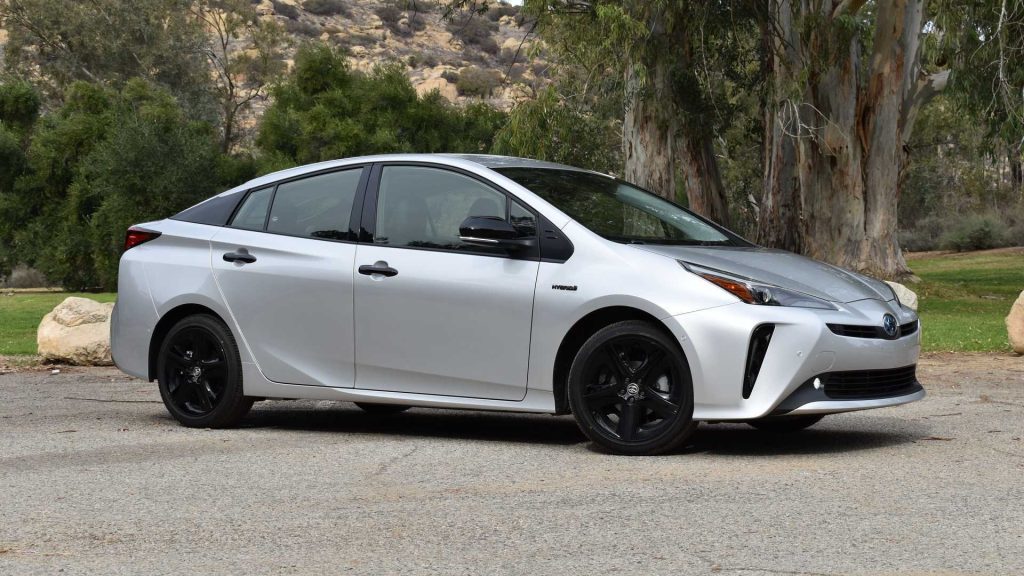
The third and fourth generations brought refinements in efficiency, comfort, and technology, while the current fifth-generation model, launched in 2023, showcases a more stylish and sporty design with enhanced performance.
Toyota also offers the Prius Prime, a plug-in hybrid variant that allows for short all-electric trips and can be charged from a standard outlet, combining the benefits of both hybrid and electric vehicles.
Modern Prius models come equipped with advanced technology and safety features, including Toyota Safety Sense, adaptive cruise control, lane-keeping assist, and intuitive infotainment systems.
The Prius has earned a reputation for reliability, low operating costs, and practicality, making it especially popular among environmentally conscious drivers and commuters.
Despite growing competition in the hybrid and electric vehicle segments, the Toyota Prius remains a top choice for those seeking a proven, efficient, and dependable hybrid car.
Toyota Corolla Hybrid — 35.6% depreciation
Affordable, efficient, and highly practical, the Corolla Hybrid is a relatively new addition to Toyota’s lineup, yet it’s already building a strong reputation for value retention. With a depreciation rate of just 35.6%, the Corolla Hybrid loses only $8,471 over five years.
Its appeal lies in offering a hybrid powertrain within a familiar, straightforward package. Thanks to one of the lowest average dollar losses on the list, it stands out as a smart option for cost-conscious buyers who don’t want to sacrifice reliability or efficiency.
As part of its mid-life refresh, the Toyota Corolla’s base 1.8-litre engine received a substantial power boost, now delivering 138bhp.
This results in a 0-62mph acceleration time of 9.1 seconds, making it quicker than the entry-level 114bhp 1.5-litre VW Golf, which takes 9.9 seconds. Although it’s about half a second slower than the more powerful 1.0 Ecoboost 155 Ford Focus, that minor gap isn’t particularly concerning.
Why is that? Because the 1.8-litre Corolla offers ample performance for daily driving needs, reaching motorway speeds with ease and without requiring you to bury your foot into the accelerator. The only situation where you might crave more power is when overtaking a slow-moving driver while the car is fully loaded with passengers and luggage.
In such scenarios, the more powerful 193bhp 2.0-litre version is a better fit, cutting the 0-62mph time down to 7.4 seconds—making it faster than every Honda Civic except the Type R. Even in typical driving, when you’re not pressing hard on the pedal, the stronger electric motor in this version delivers quicker, more satisfying responses.
When it comes to suspension and ride comfort, the Corolla offers an impressively pampering experience—enough to rival a spa day.
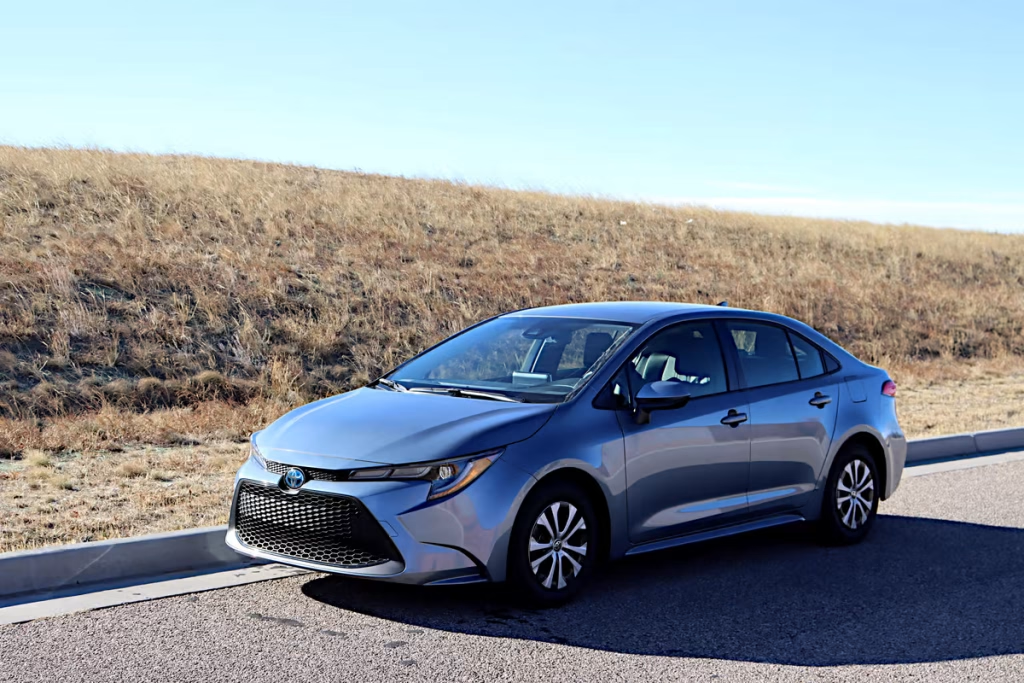
Among family cars, it stands out as one of the most comfortable options available. Even when compared to the notably smooth Ford Focus, the Corolla’s softer suspension does a better job at ironing out road imperfections and is less unsettled by uneven motorway surfaces.
The downside to this plush ride is that the body tends to move slightly more over undulating roads. However, it’s still better controlled than rivals like the Peugeot 308.
That said, it’s worth steering clear of the larger 18-inch alloy wheels found on GR Sport and Excel trims. While they don’t completely spoil the ride, they do make sharp bumps and road imperfections more noticeable.
Toyota Highlander Hybrid — 39.8% depreciation
If you need three rows of seating without sacrificing long-term value, the Highlander Hybrid fits the bill. Tied for fifth place with a 39.8% depreciation rate over five years, it’s one of the few midsize SUVs to make the list.
Despite having a higher initial cost than some other hybrids, it still retains its value better than average, with a $18,432 loss from its original MSRP. For families seeking both spaciousness and fuel efficiency, the Highlander Hybrid is a standout choice.
Toyota offers a wide range of three-row SUV options, and the Highlander Hybrid stands out as one of the more carlike models in the lineup.
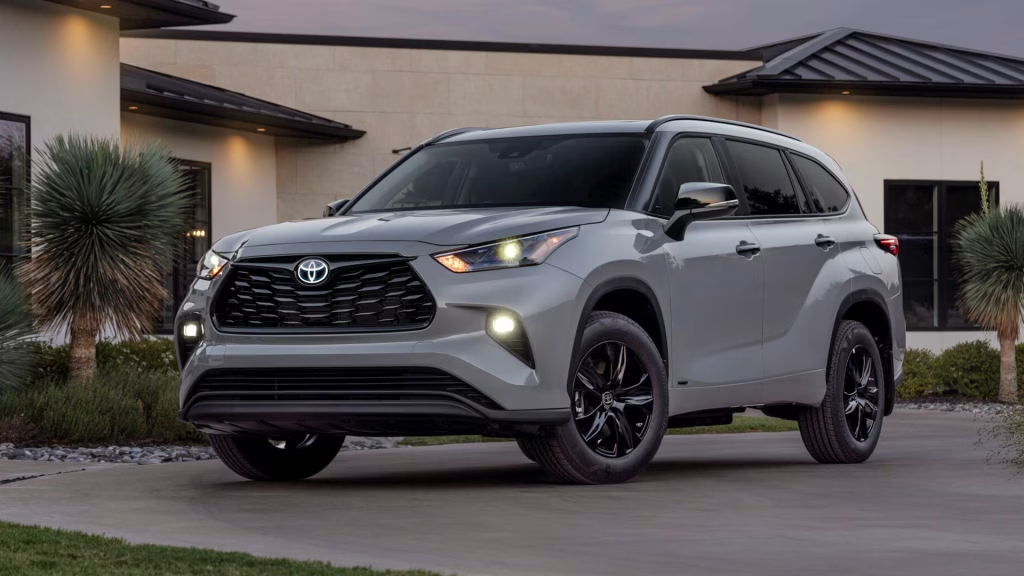
It accommodates seven or eight passengers while maintaining impressively low fuel consumption, making it well-suited for family duties. Under the hood, a 2.5-liter four-cylinder engine is paired with three electric motors, resulting in a combined output of 243 horsepower and all-wheel-drive capability.
While the Highlander Hybrid doesn’t aim to deliver thrilling performance or sporty driving dynamics, it provides a smooth and comfortable ride that easily keeps pace with everyday traffic.
Its third row is somewhat compact, making it more suitable for smaller families who need two extra seats for occasional use rather than for regular adult passengers.
For those seeking more room, the Toyota Grand Highlander Hybrid offers a more spacious interior along with a stronger gas-electric powertrain.
Alternatively, if you prioritize both space efficiency and fuel economy, the Toyota Sienna minivan is worth considering. It shares the same hybrid powertrain as the Highlander and is available in both front- and all-wheel-drive configurations.
Toyota Camry Hybrid — 39.8% depreciation
While sedans may be declining in popularity, the Camry Hybrid continues to hold its ground. Like the Highlander Hybrid, it retains 60% of its value after five years, with an average depreciation of $11,486. Its strong appeal lies in its roomy interior, smooth ride, and outstanding fuel economy.
Popular among both commuters and families, the Camry Hybrid also benefits from a low cost of ownership, making it an attractive and sensible option for those who want long-term savings and dependable performance.
Automakers have been accelerating their electrification efforts across their lineups, and Toyota is no exception.
In fact, Toyota has been a pioneer in this area, largely due to the groundbreaking Prius hybrid. For 2025, the Camry returns exclusively as a hybrid, though its redesign is less dramatic than anticipated.
Nevertheless, with evolutionary improvements, this midsize sedan is poised to continue offering a highly efficient choice for buyers seeking spacious, conventional transportation.
What’s new for the 2025 Camry includes a redesigned front fascia and a restyled interior, with a hybrid drivetrain now standard across the board. An available e-AWD system enhances traction, while a re-engineered suspension setup and new braking system improve ride and handling.
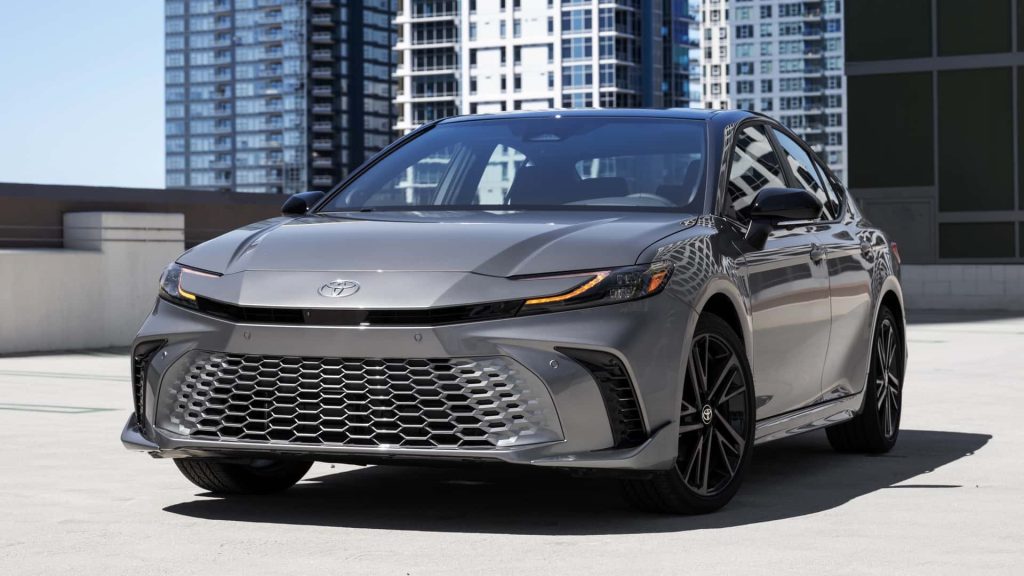
Inside, the car features a standard 7.0-inch digital gauge cluster, with an available 12.3-inch cluster and a 10.0-inch head-up display option. The infotainment system includes a standard 8.0-inch touchscreen and an available larger 12.3-inch version, alongside standard wireless charging.
Redesigned seats are available for all trims, complemented by standard Toyota Safety Sense 3.0, push-button start, dual-climate control with rear air vents, and blind-spot monitoring with rear cross-traffic alert.
Higher trims (XLE and XSE) can be equipped with a power panoramic roof, and new paint colors—Ocean Gem and Heavy Metal—are introduced, along with available two-tone exterior schemes for the XSE trim.
Our impression is that the 2025 Camry closely resembles the outgoing model, with the front end receiving slightly more expressive headlights, while the side and rear remain largely unchanged. Inside, the cabin sees some thoughtful upgrades but retains a straightforward, simple design.
Surprisingly, when driven, the 2025 Camry proves to be enjoyable. The electric motor provides brisk off-the-line acceleration, and Toyota’s hybrid expertise is evident in the smooth and consistent brake feel.
Handling has improved, with more precise steering and a composed, planted ride. While not a sports car, the Camry offers a driving experience that will appeal to both commuters and enthusiasts.
Although Toyota didn’t radically transform the Camry as it did the Prius, its approach was wise. The 2025 Camry stays true to its core values of approachability, value, and quality while gaining added pep and personality. This combination should help the Camry remain a popular choice among midsize sedans.
In terms of performance and fuel economy, the 2025 Camry Hybrid benefits from a more powerful version of Toyota’s hybrid system.
A 2.5-liter four-cylinder engine teams up with dual electric motors to deliver 225 horsepower to the front wheels—an increase of 17 hp over the previous model.
All-wheel-drive variants add a rear electric motor, boosting total system output to 232 hp. Testing shows the Camry can accelerate from 0 to 60 mph in just 6.9 seconds.
Fuel efficiency remains strong, with Toyota stating that the most economical version is the Camry LE FWD, which achieves 53 mpg city and 50 mpg highway. The sportier XSE trim is less efficient, returning 48 mpg city and 47 mpg highway with front-wheel drive.
Adding all-wheel drive lowers fuel economy by one to four miles per gallon, depending on the specific model and driving conditions. Overall, these fuel economy figures are not significantly improved from the 2024 Camry.
Hybrid Cars That Do Not Retain Value
In a car market where depreciation remains one of the most significant costs for consumers, hybrids have traditionally offered a secure option. They’re efficient, practical, and continue to be in strong demand — especially as fuel prices fluctuate unpredictably.
However, not every hybrid holds its value equally well. A new study by iSeeCars, which examined more than 800,000 five-year-old used vehicles, reveals that some hybrid models are depreciating at a faster rate than others, even within a segment known for solid value retention.
Overall, hybrids lose just 40.7% of their value after five years, which is notably better than the industry average of 45.6%. Yet these ten hybrid models all fall below that benchmark, experiencing steeper declines in resale value.
Some are luxury crossovers, others are older designs, and several suffer from limited name recognition or lackluster market demand. Here are the ten hybrids that retain the least value compared to their peers.
BMW 5 Series – 64.7% depreciation
Leading the list of hybrids with the worst resale value is the BMW 5 Series, which depreciates by a substantial 64.7% — translating to nearly $47,500 in lost value over five years.
As a luxury midsize sedan, the 5 Series Hybrid contends with fierce internal competition from BMW’s own lineup, in addition to pressure from rival brands.
Its high original price, rapidly aging tech features, and expensive maintenance contribute significantly to its accelerated depreciation. For buyers focused on long-term value, this hybrid may be more suitable as a lease rather than a long-term purchase.
Even in its entry-level 520i version, the BMW 5 Series isn’t sluggish—accelerating from 0 to 62 mph in 7.5 seconds—but you do need to push the engine hard if you want to accelerate quickly.
The standard eight-speed automatic transmission generally shifts smoothly and intelligently, yet when you demand a sudden burst of speed, it can hesitate noticeably before downshifting with a sharp jolt.
For a more responsive driving experience, the BMW 530e plug-in hybrid (PHEV) is worth considering. This model offers greater power, and the electric motor helps fill in any acceleration gaps, reducing the 0-62 mph time to 6.3 seconds. The other PHEV in the 5 Series lineup, the 550e, is even faster, trimming two seconds off the sprint time.
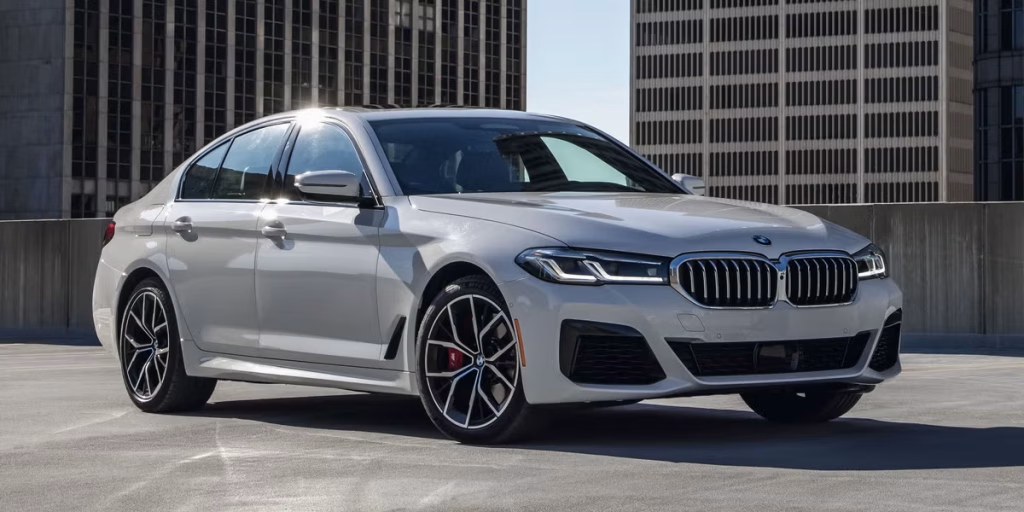
Both plug-in hybrids boast impressive electric-only ranges: the 550e can officially travel 55 miles on a charge, while the 530e can manage 63 miles. However, the Mercedes E300e surpasses both, offering around 70 miles of electric range.
BMW models tend to shine when equipped with adaptive suspension, but even the standard passive setup on the 520i and 530e delivers good handling.
The 5 Series controls body roll more effectively than rivals like the Audi A6 or Mercedes E-Class, and its precise, well-weighted steering boosts driver confidence through corners.
On the downside, you may notice some fidgeting over rough surfaces, particularly in the heavier PHEV versions, though none of the 5 Series models feel excessively harsh when encountering larger bumps or potholes.
Regarding refinement, the 520i’s engine is smooth and quiet at steady cruising speeds, with a pleasingly throaty character when pushed hard. The 530e shares these qualities but, as a PHEV, can operate on electric power alone at low speeds, enabling silent driving around town.
At higher speeds, there is more wind noise from around the door mirrors on the 5 Series than in the Mercedes E-Class, but overall, it remains a quiet car.
Volvo XC60 – 57.4% depreciation
The Volvo XC60 combines stylish Scandinavian design with plug-in hybrid capability, but its depreciation figures paint a less favorable picture.
With a 57.4% depreciation rate and more than $33,000 in value lost after five years, it ranks among the hybrids with the weakest value retention.
Even though the XC60 offers excellent safety scores and a high-end interior, potential buyers may hesitate due to concerns about costly repairs and quickly evolving plug-in hybrid technology. In a crowded premium SUV segment, the XC60 finds it difficult to maintain a strong presence in the used market.
Modern SUVs like the Volvo XC60 are true all-rounders, much like an automotive Leatherman—they adapt effortlessly to any situation. Whether it’s a business trip, a school run, or a quick shopping trip to the city center, the XC60 handles it all with ease. Want to feel relaxed and just a little bit stylish?
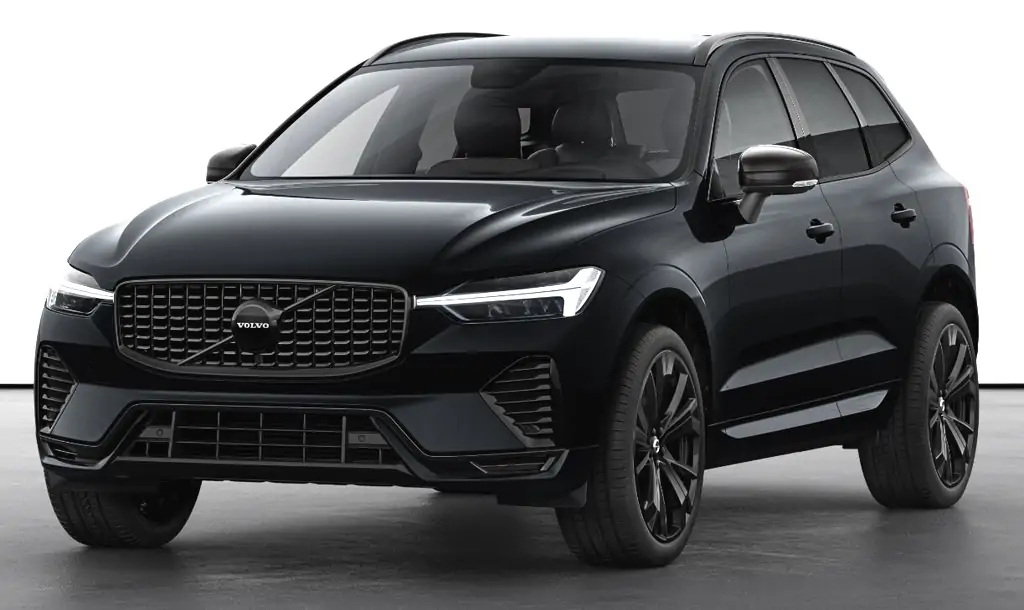
Need to haul some bulky items to the tip? If that sounds like your kind of vehicle, heading to your nearest Volvo dealership is a smart move, especially since the XC60 comes equipped with advanced safety technology that outpaces most competitors.
Unlike the more conventional Audi Q5 and Mercedes GLC, the XC60 makes a bold statement with its striking Thor’s hammer-style headlights (yes, that’s what Volvo calls them), a sleek, swept-back windshield, and unique hook-shaped rear lights.
Inside, the XC60 boasts a comfortable, stylish, and understated cabin. Its minimalist design—reminiscent of Swedish furniture—means you won’t find an overload of buttons cluttering the dashboard. Instead, most features are controlled via a central touchscreen.
However, while the screen looks like something you might find in a high-end cocktail bar, it’s not quite as user-friendly as the Mazda CX-5’s more straightforward system, which uses an old-fashioned rotary dial. All the driving settings are tucked away in this interface, making it somewhat tricky to adjust them on the move.
Getting comfortable behind the wheel is straightforward. Higher-spec XC60s come with highly comfortable electric memory seats, so you only need to set your position once. Rear passengers also enjoy ample comfort, with enough space for three adults to sit side-by-side and generous shoulder room.
The boot is quite spacious, offering plenty of room for a family’s luggage or a large bike once the rear seats are folded down. That said, if maximum cargo capacity is a priority, the Audi Q5 and Mercedes GLC both outsize the XC60.
“An interior that looks and feels great plus a range of efficient engines make the XC60 a tempting package,” says expert car reviewer Mat Watson.
Choosing an engine for the XC60 is relatively straightforward since most options deliver both good power and efficiency. The 2.0-litre petrol and diesel engines are the standout choices.
The petrol variant suits mostly urban driving, while the diesel excels on long-distance trips thanks to better fuel economy. There are also two plug-in hybrid variants available, offering benefits like lower Benefit-in-Kind tax and the ability to regularly recharge the electric battery.
Regardless of the engine choice, the XC60 prioritizes a relaxing driving experience above all else. It may not be the most thrilling on a twisty road, and it can feel a bit bumpy around town—especially if equipped with larger alloy wheels, even with air suspension—but on the motorway, its comfort level is exceptional, helping you arrive less fatigued.
This is especially true with the Ultimate trim, which features the Four-C adaptive air suspension. Equipment-wise, the XC60 impresses. All models come standard with an automatic gearbox, and you can choose between two- or four-wheel drive depending on the variant.
The safety suite is extensive as well; while some features like emergency automatic braking are common in many cars today, Volvo includes unique touches such as seat bases engineered to absorb vertical impacts if you accidentally leave the road, underscoring the brand’s deep commitment to safety.
Mercedes-Benz GLC – 54.3% depreciation
The GLC blends Mercedes-Benz luxury with limited electric driving capability, but that refinement comes with a price. Over five years, the GLC loses more than half its original value, with an average depreciation of $32,552.
Like many luxury hybrid models, the GLC is affected by rapid advances in technology and high maintenance costs, which can make prospective used buyers hesitant.
The Mercedes GLC is a premium mid-size SUV that draws inspiration from the C-Class saloon but provides a higher driving position and more robust styling. It competes with rivals such as the Audi Q5, BMW X3, Porsche Macan, and Volvo XC60.
Much like a Swatch watch, the GLC features some high-quality components that contribute to its popularity, yet it also surprises with a few elements that feel less refined. In terms of looks, the Mercedes arguably stands out as the best-looking among medium-sized premium SUVs.
It commands attention with a wide bar stretching across the grille, topped by the glossy Mercedes emblem. Sporty touches are evident as well, since all UK models come with AMG-inspired trim levels.
The vehicle rides on either 19- or 20-inch alloy wheels, with the larger alloys filling the wheel arches more effectively.
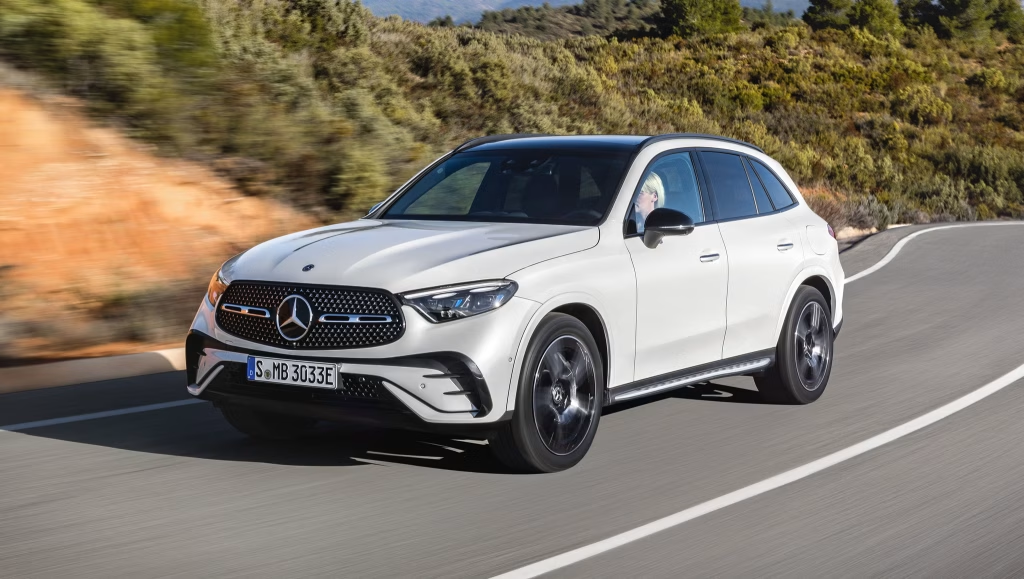
Chrome detailing throughout adds to the upscale impression. At the rear, there’s a bit of trickery with fake exhaust openings, but overall, the GLC maintains a strong presence and looks quite attractive.
Inside, the cabin continues Mercedes’ tradition of crafting appealing environments. Drivers and passengers benefit from two large, clear, easy-to-use, and customizable displays.
The overall design is visually pleasing, although the GLC does fall short of matching its relatively high price tag in some areas, such as the scratchy plastics found at common touchpoints like the gear stalk and center console.
Mitsubishi Outlander PHEV – 53.4% depreciation
Once seen as a trailblazer among plug-in hybrids, the Mitsubishi Outlander PHEV has since been surpassed by newer, more advanced competitors.
Its dated interior design and unimpressive electric-only range likely contribute to its high depreciation. After five years, the Outlander PHEV drops in value by 53.4%, which amounts to roughly $21,600 — making it a less-than-ideal investment despite its fuel-saving hybrid credentials.
The Mitsubishi Outlander PHEV is a high-riding hybrid family vehicle worth considering if you want something economical, quiet, and better suited for city driving than competitors like the Skoda Kodiaq and VW Tiguan.
Visually, it certainly stands out more than those models. While it doesn’t quite match the eye-catching Toyota RAV4, the Outlander PHEV’s angular front end, large chrome accents, and absence of matte black bumper extensions give it more visual impact than many practical family SUVs.
Unfortunately, it seems Mitsubishi’s design team lost momentum when it came to the interior of the Outlander PHEV—it feels somewhat bland.
Although a touchscreen infotainment system is standard and mid-range trims can come with bright red seats, the cabin doesn’t look or feel as refined as the interiors found in the Skoda Kodiaq or Toyota RAV4. So, while the Outlander PHEV’s interior isn’t the most stylish, it is among the roomiest.
All five seats can comfortably accommodate six-foot-tall adults, and despite the batteries taking up some space under the floor, the boot remains fairly spacious. It is unfortunate, however, that unlike the standard Outlander or Skoda Kodiaq, you can’t opt for a third-row seat in the Outlander PHEV.
That said, the Toyota RAV4 hybrid doesn’t offer extra seats either, so this isn’t a major disadvantage. Plus, the Outlander PHEV features a more advanced hybrid system than the Toyota.

This means you can drive nearly 30 miles on electric power alone and achieve over 100mpg if you drive carefully and keep the battery fully charged whenever possible.
Even when the petrol engine kicks in, the Outlander PHEV remains quite economical. It’s also easy to maneuver around town, especially in the near-silent electric mode.
However, some alternatives provide a more comfortable ride and come with more advanced driver assistance systems as standard. Still, the Outlander PHEV offers excellent visibility, and it’s equipped with enough sensors and cameras to help prevent minor bumps and scrapes while parking.
It handles twisty country roads reasonably well for a high-riding hybrid SUV, though it isn’t as quick or as engaging to drive as many conventional petrol or diesel rivals. Don’t let that discourage you, though.
The Mitsubishi Outlander PHEV is a very capable SUV and is certainly worth considering if you want an easy-to-drive, impressively economical option for city driving—provided you have a place to charge it overnight.
Ford Escape Hybrid – 52.3% depreciation
The Ford Escape Hybrid returned to the market with respectable EPA fuel efficiency and a sensible, user-friendly layout. However, it hasn’t gained the same popularity as Toyota’s hybrid models.
With a 52.3% depreciation rate, equating to $17,000 in lost value after five years, the Escape Hybrid appears to be struggling with consumer perception. Its frequent updates and relatively unremarkable design may be contributing to its weaker performance in long-term value retention.
Amid reports suggesting the Ford Escape could be discontinued soon, the automaker has streamlined its available features and, in some cases, rolled them back to keep prices down.
This strategy has resulted in the 2025 Escape models being less expensive than those from last year. Ford is expected to introduce a fully electric replacement within the next couple of years.
The changes for the 2025 Ford Escape include the Rapid Red exterior paint replacing Race Red, and Space Silver taking the place of Iconic Silver on the Active base model.
Most trims now come with a tire repair kit instead of a spare tire. The power driver’s seat is now optional for the Active model, while a power liftgate is optional for the bottom two trims.
A 360-degree camera is now available as an option across all models, but ambient lighting has been discontinued. Ford’s small crossover continues to offer plenty of strengths, and that remains true for 2025.
The optional 2.0-liter turbocharged four-cylinder engine delivers impressive performance, and the Escape’s platform provides a surprisingly agile driving experience regardless of powertrain choice. For those prioritizing fuel efficiency, Ford also offers hybrid and plug-in hybrid variants.
The digital displays inside the Escape are striking, though the interior material quality is somewhat inconsistent.
The seats feel flat and lack adequate comfort for long journeys, and there is a noticeable presence of grainy plastic trim once you move beyond the expansive screen area. The ride can feel a bit harsh, and the base engine’s power delivery doesn’t feel as smooth as some competitors’ SUVs.
Opting for a higher trim with the 2.0-liter turbo-four engine and a larger infotainment screen makes the Escape more appealing for drivers who value performance and modern technology. However, despite its positive attributes, the Escape struggles to truly stand out in an increasingly crowded segment.

